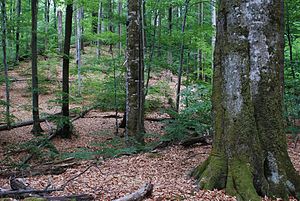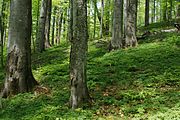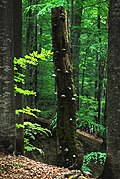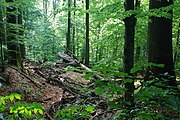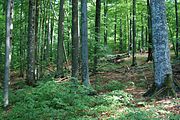
The Paklenica karst river canyon is a national park in Croatia. It is near Starigrad, northern Dalmatia, on the southern slopes of Velebit mountain, not far from Zadar. It contains two canyons, Mala (Small) and Velika (Big) Paklenica. Today there is no water flowing through Mala Paklenica. Near the entrance to the Velika Paklenica is an artificial tunnel complex built for Josip Broz Tito during the tension between Yugoslavia and the USSR in the late 1940s and early 1950s.
UNESCO Biosphere Reserves are environment-protected scientific-research institutions of international status that are created with the intent for conservation in a natural state the most typical natural complexes of biosphere, conducting background ecological monitoring, studying of the surrounding natural environment, its changes under the activity of anthropogenic factors.

Fagus sylvatica, the European beech or common beech is a large, graceful deciduous tree in the beech family with smooth silvery-gray bark, large leaf area, and a short trunk with low branches.
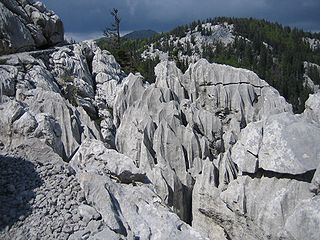
The Northern Velebit National Park is a national park in Croatia that covers 109 km2 of the northern section of the Velebit mountains, the largest mountain range in Croatia. Because of the abundant variety of this part of the Velebit range, the area was upgraded from a nature reserve in 1999, and opened as a national park in September the same year.

The Slovak Karst is one of the mountain ranges of the Slovenské Rudohorie mountains in the Carpathians in southern Slovakia. It consists of a complex of huge karst plains and plateaus. Since 1973 it has been a protected landscape area. On 1 March 2002 Slovak Karst National Park was declared. It is also a UNESCO Biosphere Reserve and part of it forms UNESCO World Heritage Site Caves of Aggtelek Karst and Slovak Karst.

Bieszczady National Park is the third-largest national park in Poland, located in Subcarpathian Voivodeship in the extreme southeast corner of the country. In 2021, the national park became a UNESCO World Heritage Site.

Poloniny National Park is a national park in northeastern Slovakia at the Polish and Ukrainian borders, in the Bukovské vrchy mountain range, which belongs to the Eastern Carpathians. It was created on 1 October 1997 with a protected area of 298.05 km2 (115.08 sq mi) and a buffer zone of 109.73 km2 (42.37 sq mi). Selected areas of the park are included into Primeval Beech Forests of the Carpathians UNESCO World Heritage Site.

Ancient and Primeval Beech Forests of the Carpathians and Other Regions of Europe is a transnational serial nature UNESCO World Heritage Site, encompassing 93 component parts in 18 European countries. Together, the sites protect the largest and least disturbed forests dominated by the beech tree. In many of these stands, these forests here were allowed to proceed without interruption or interference since the last ice age. These sites document the undisturbed postglacial repopulation of the species.
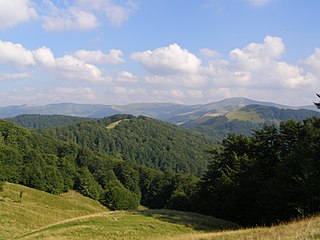
The Svydovets is a mountain range in western Ukraine, one of the ranges of Eastern Beskids, itself belonging to the Outer Eastern Carpathians. It is a biodiversity hotspot in the Ukrainian Carpathians. The territories of the Svydovets mountain range belong to the state. The highest peak of the range is Blysnyzi mountain. The Black Tisza, the source of Tisza, is one of the more fullflowing rivers of the region, it flows out from the Svydovets.
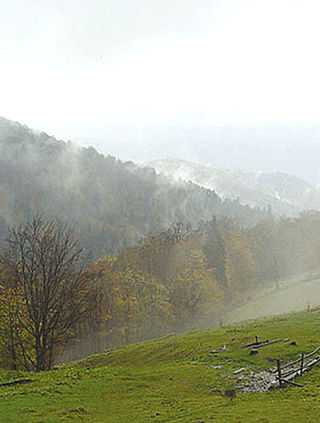
Vyzhnytsia National Nature Park is a protected area in south-western Ukraine which administration is located in the town Berehomet. The park has 87 employees with 6 of them working in the scientific section and 29 in the security service. The park was created for the conservation, restoration and sustainable use of natural landscapes of Bukovinian Carpathian with its unique historical and cultural complexes.
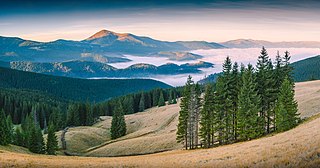
Carpathian Biosphere Reserve is a biosphere reserve in Ukraine that was established in 1968 and became part of the World Network of Biosphere Reserves of UNESCO in 1992. Since 2007 bigger portion of the reserve along with some territories of the Uzh River National Park was listed with the UNESCO World Heritage Sites as part of the Ancient and Primeval Beech Forests of the Carpathians and Other Regions of Europe.
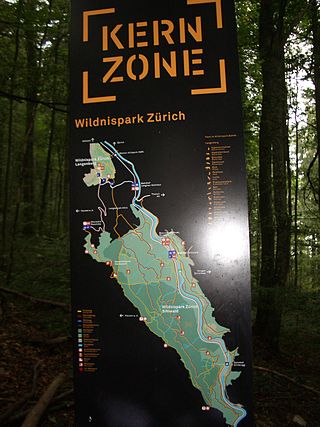
Zürich Wilderness Park is a wilderness park near the city of Zürich in Switzerland. It includes the Sihlwald forest, the largest mixed deciduous and coniferous forest in the Swiss Mittelland, and the Langenberg Wildlife Park, the oldest Swiss wildlife park. Both sites are situated in the Sihl Valley to the south of Zürich, but are separated from each other by the town of Langnau am Albis.
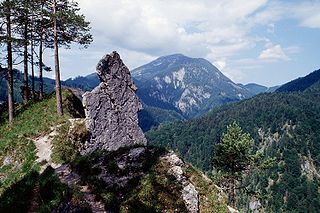
Kalkalpen National Park is a national park within the Northern Limestone Alps mountain range, located in the state of Upper Austria, Austria. The park was established in 1997. The ancient beech forests within the national park were added to the UNESCO World Heritage Site known as Ancient and Primeval Beech Forests of the Carpathians and Other Regions of Europe, because of their undisturbed nature and testimony to the ecological history of Europe since the Last Glacial Period.

Natural beech wood is a beech wood, that is able to replenish and sustain itself on its own.

The wildlife of Ukraine consists of its diverse fauna, flora and funga. The reported fauna consists of 45,000 species when including the areas of the Black Sea and the Sea of Azov. Ukraine's protected environments consist of 33 Ramsar sites covering an area of 7,446.51 square kilometres (2,875.11 sq mi). Biosphere nature reserves and three national parks are all part of the GEF projects portfolio of conservation of biodiversity in the Danube Delta. Their vegetation pattern is mixed forest area, forest-steppe area, steppe area, Ukrainian Carpathian Mountains and Crimean Mountains. Some of the protected areas that were reserves or parks are subsumed under the biosphere reserves.

Svydovets protected massif Ukrainian: Свидовецький заповідний масив is a protected area in the Ukrainian Carpathians near Rakhiv in the Zakarpattya region. The protected massif has an area of 6,580 hectares and is located at an elevation of 600–1883 m.a.s.l. in the highest region of the Svydovets mountain range.

Uzh National Nature Park is a protected area in Ukraine. It is located in Uzhhorod Raion of Zakarpattia Oblast, at the border with Poland and Slovakia. The park was created on 5 August 1999 and has the area of 39,159.3 hectares (151.195 sq mi). Since 2007, it is part of the World Heritage site Primeval Beech Forests of the Carpathians and Other Regions of Europe. It is also part of the East Carpathian Biosphere Reserve. The park was created to protect pristine beech forest of the Carpathians.

The Carpathian montane conifer forests, also known as Carpathian montane forests, is a temperate coniferous forests ecoregion in the Carpathian Mountains of the Czech Republic, Poland, Slovakia, Romania, and Ukraine.

Pyxine sorediata, commonly known as mustard lichen, is a widely distributed species of foliose lichen in the family Caliciaceae. It has a subtropical to warm temperate distribution, and grows on bark, rocks, and moss as substrates. Pyxine sorediata has been reported from regions of North America, Europe, Africa, Asia, and Australasia.
Lecanora substerilis is a species of corticolous (bark-dwelling), crustose lichen in the family Lecanoraceae. It is found in Eastern Europe, in old-growth beech forests of the Carpathian Mountains in the Czech Republic, Slovakia, Romania and Ukraine.
